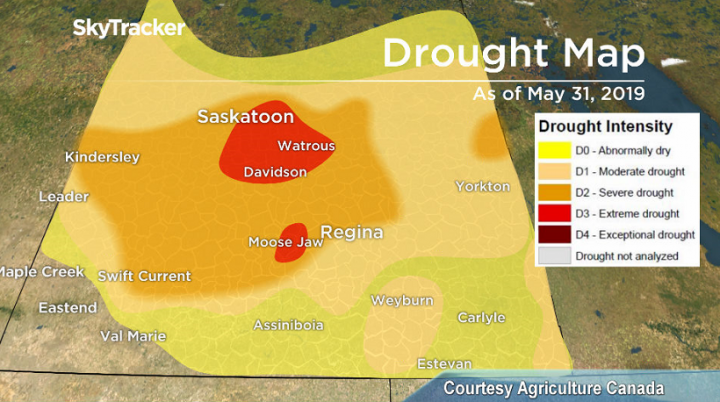Environment Canada meteorologist Terri Lang says a lot of rain is needed in parts of Saskatchewan to ease the current drought conditions.

“Probably over 200 millimetres for many parts of the southern Saskatchewan,” Lang told Global News on Tuesday.
Saskatoon and Moose Jaw had the driest spring ever recorded for the cities and the Canadian Drought Monitor reports that an extreme drought currently exists in both areas.
Other parts of the province were nearly as dry.
Swift Current, North Battleford and Key Lake experienced their third-driest spring, while Regina posted its eighth-driest spring.
“We’re still waiting for those rains to come,” Lang said.
“The southeast got a little bit of rain over the weekend but we still need a lot more rain to make up for that huge deficit that we have.”
Shower activity will be scattered and spotty this week, with a chance of pop-up showers and risk of a thunderstorm, according to Global News meteorologist Peter Quinlan.

Get breaking National news
Amounts will vary from zero up to 10 millimetres depending on where the hit-or-miss showers and thunderstorms end up sitting.
The lack of moisture is having an adverse effect on agriculture operations.
Saskatchewan Agriculture rated cropland topsoil moisture at 78 per cent short or very short in its June 6 crop report as conditions deteriorate due to strong winds and the lack of moisture.
Agriculture officials said significant rainfall is needed as growth is delayed in much of the province.
With the dryness comes a heightened risk of grass fires in the south, which Lang said is late for this time of year.
“It’s because of the dryness, things aren’t greening up as fast as they should and because things are still so dry that grass fire risk still does exist,” Lang said.
While some grass fires are caused by lightning, most are manmade, Lang said.
“That could be as simple as a train going by and setting off some sparks or maybe a tractor on some dry grass, that type of thing, and if there’s some wind around it can really take off,” she said.
The wildfire situation has eased in northern Saskatchewan.
“The north got quite a bit of rain over the weekend, so they’re sitting rather nice especially that’ll put a damper on wildfire activity up there,” Lang said.
The dryness has also slowed the start of severe weather in the province.
“We’ve only had a couple bits of severe weather so far and that was in the southeast corner,” Lang said.
“As it greens up, we should get more severe weather because it kind of feeds into one another – the more rain that you get, the ground gives off more moisture.”
Lang said the last “really wet year” in the province was in 2014.
-With files from Ryan Kessler







Comments